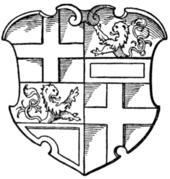charges should be when represented upon a simple shield should be determined by the position of the helmet. It may be of interest to state that in St. George's Chapel at Windsor the early Stall plates as originally set up were all disposed so that helmets and charges alike faced the High Altar.
 Fig. 765. |
 Fig. 766.—Arms of Loschau or Lexaw, of Augsburg. |
 Fig. 767. |

Fig. 768.—Arms of the Elector and Archbishop of Treves.
The conjunction of three coats of arms in Germany is effected as shown in Fig. 764. Although matrimonial alliance does not in Germany entail the conjunction of different coats of arms on one shield, such conjunction does occur in German heraldry, but it is comparable (in its meaning) with our rules of quartering and not with our rules of impalement. No such exact and definite rules exist in that country as are to be met with in our own to determine the choice of a method of conjunction, nor to indicate the significance to be presumed from whatever method may be found in use. Personal selection and the adaptability to any particular method of the tinctures and the charges themselves of the coats to be conjoined seem to be the determining factors, and the existing territorial attributes of German armory have a greater weight in marshalling than the principle of heirship which is now practically the sole governing factor in British heraldry. One must therefore content oneself with a brief recital of some of the various modes of conjunction which have been or are still practised. These include impalement per pale or per fess (Fig. 765) and dimidiation (Fig. 766), which is more usual on the Continent than it ever was in these kingdoms. The subdivision of the field, as with ourselves, is most frequently adopted; though we are usually confined to quartering, German armory knows no such restrictions. The most usual subdivisions are as given in Fig. 767. The ordinary quartered shield is met with in Fig. 768, which represents the arms of James III., Von Eltz, Elector and Archbishop of Treves (1567-1581), in which his personal arms of Eltz ("Per fess gules and argent, in chief a demi-lion issuing or") are quartered with the impersonal arms of his archbishopric, "Argent, a cross gules." Another method of conjunction is superimposition, by which the design of the one shield takes the form of an ordinary imposed
